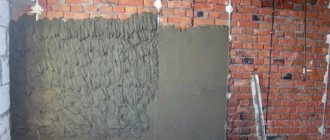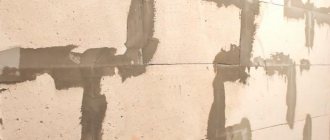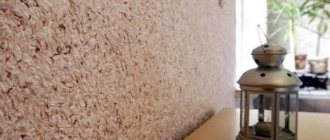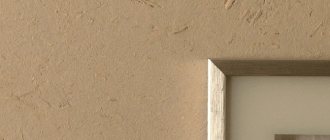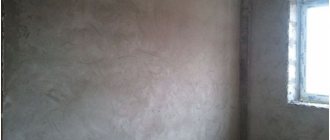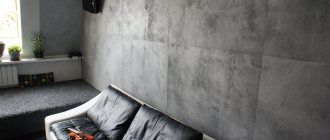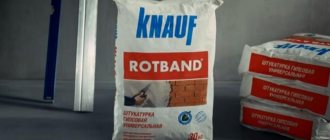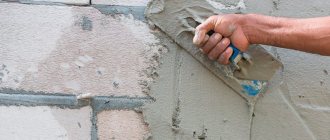Barite is a mineral with a specific gravity of 4.3-4.7 t/m³, which is 1.7-1.8 times heavier than granite.
When ground, it is included as a filler in a dry construction mixture called barite plaster (BS). The high density of the stone determines its protective properties against X-rays.
Therefore, the scope of application of the mixture is limited to its main purpose - where there is a need for protection from X-rays.
Scope of application
Barite filler is a white powder, and a dry mixture based on it can be used as plaster for leveling surfaces. The main purpose of use is to protect people in rooms located near places where X-rays are used.
These are production facilities and institutions operating devices with radiation sources:
- dental clinics, X-ray, tomography rooms;
- industrial enterprises where there are technological processes using radioactive substances;
- laboratories, research institutes conducting tests using gamma rays;
- storage facilities for radioactive elements.
Barite X-ray protective plaster replaces expensive lead screens. When a higher degree of protection is needed, slabs cut from barite are used.
General recommendations
Before plastering with barite plaster, all wiring and utilities must already be installed. It is strictly forbidden to scratch the plaster - there will be places with insufficient screening of X-rays.
Never dry plaster using fans or even heat guns. Accelerated drying will not allow the cement to gain strength, and as a result, the plaster begins to crumble. And this is extremely dangerous when using barite plaster.
Crack formation due to improper drying
Very dry brick walls must be pre-wetted. Such a wall quickly absorbs water, and the adhesion coefficient decreases sharply.
If the room temperature is above +22–25°C, then after finishing the work the wall should be wetted; it is better to do this at night.
Before plastering, it is recommended to check the solution; if it does not adhere well to the wall, then add a little cement. A lack of cement is also indicated by the rapid separation of the mass into water and solid fractions.
The main advice is that barite plaster belongs to a complex of special protective construction works, which are subject to very high requirements for quality and adherence to technology. Take your time, work carefully and responsibly.
Requirements of sanitary authorities for the application of barite plaster
Monitoring the sanitary and epidemiological well-being of people is carried out by the State Sanitary and Epidemiological Supervision. The use of barite plaster is subject to SanPiN 2.6.1.1192-03 “Hygienic requirements for X-ray rooms.” Supervision of the barite coating includes checking the barite content in the mixture according to the technical specifications of GOST 4682-84, and the plaster consumption depending on the thickness of the protective layer.
Compliance of the indicators is checked according to test reports of the shielding coating, compiled in accordance with the form of the GOST 12.4.217-2001 safety standards system.
Procedure for preparing barite concrete mixture M200
A protective solution with a strength of 200 kg/cm² is used for pouring floors, making partition concrete blocks, pouring walls using formwork, and plastering surfaces. The mixture for making barite concrete can be completely dry or consist of a liquid hardener with a volume of 6 liters and barite powder weighing 24 kg with polymer additives.
Procedure for preparing the solution:
- Place the components in a concrete mixer and mix until smooth.
- Add water in small portions until the desired consistency is achieved. For plastering, the mixture is made more liquid, and the floors and walls are filled with a viscous solution.
- The prepared barite concrete must be consumed within 45 minutes: after this time, polymerization begins, causing the mixture to dry out irreversibly.
The latter circumstance obliges the master to calculate the number of loaded components based on the number of workers laying the solution.
Consumption per 1 m2
The design documentation for a facility with sources of radioactive radiation provides for protection with lead shields. The thickness of the plates is calculated based on the maximum gamma radiation power.
The thickness of the plaster layer is based on the thickness of the lead protection. It is difficult to determine the exact value due to the uneven quality of barite powder from different manufacturers: the barite content in the mixture ranges from 85-95%.
The dependence of the thickness of barite plaster coatings, plaster consumption per 1 m², calculated based on the thickness of lead protection, are shown in the table.
| Lead screen, mm | Barite concrete, cm | Mixture consumption, kg/m² |
| 1 | 1-1,1 | 38-42 |
| 2 | 2-2,1 | 76-80 |
| 3 | 2,9-3 | 110-114 |
| 4 | 3,5-3,7 | 133-141 |
If the design capacity of the equipment changes, the degree of protection is also adjusted. In this case, coordination of corrections with sanitary authorities is mandatory.
Casting a lead sinker into a homemade plaster mold
Let's start making molds and casting weights:
- Diluted gypsum powder is poured into the square formwork.
- The sinker blank, attached to a wire, is installed in the center of the container in the not yet hardened plaster. We make holes in different parts of the workpiece.
- Before pouring the top layer, be sure to coat the bottom layer with the sinker with liquid soap - this will prevent the workpieces from sticking together.
- After applying the top layer, lightly tap the workpiece to distribute the solution evenly.
- The gypsum has frozen, you can disassemble the formwork and open the workpiece.
- Make holes in the upper part: one for sinker castings, the other for oxygen supply. The workpiece is ready for use.
- Next, we proceed similarly to the options described above: insert the wire into the workpiece and pour molten lead into the hole made.
Before fishing using the resulting sinkers, it is necessary to finalize them, make line clamps, drill holes and clean the connecting points. After processing, you will have excellent sinkers in your hands that you can take fishing.
Like different types of baits, sinkers of a certain weight and shape can also be made at home. Of course, not all fishermen are mechanics or milling machines, and not everyone has the opportunity to make metal forms, so plaster or sealant can be used as the mold material. Or contact a familiar craftsman at a local factory for a metal mold.
If the transaction is successful, within a day or two you will receive the necessary molds for casting. But first you need to take care of determining the exact diameter of the future spherical weights and inform the master about it in order to ultimately get weights of the required weight.
Plaster components
The basis of the mixture is barite sand with a fraction of up to 1.25 mm, the color is white, gray. The binder is Portland cement or magnesium cement. The latter is used when it is necessary to accelerate hardening. Based on the bonding of components, X-ray protective compositions can be barite-concrete, cement-barite, or magnesia-barite.
Ingredient Specifications:
- cement
— the strength grade should not be lower than M300;
- sand
— share in the mixture is 85-95%, depending on the brand of binder and the required strength of the solution;
- plasticizers or polymers
- make up up to 3% of the total weight, added for ease of working with sand-cement mass;
- water
- when using a factory-made dry building mixture, pour in gradually in an amount of 200 g per 1 kg of powder until the desired viscosity is obtained.
Effective protection against radiation using barite plaster can be achieved in two ways. The first is to use high-quality cement M500 so that the sand in the mixture is 95%. The second is to increase the thickness of the applied layer: work with M300 binder with a filler concentration of 85%. Both methods give equally good results.
Acid-resistant mixtures
A solution such as acid-resistant plaster is in demand in industrial premises, for example, chemical laboratories or workshops. The finish is moisture-proof and vapor-proof. It differs significantly from ordinary plaster in composition:
- potassium or sodium liquid glass is used as a binder here;
- the filler is quartz sand, as well as granite screenings, or material obtained by crushing ceramic products;
- acid-resistant cement or fine andesite powder;
- sodium fluoride, which improves the hardening process of the solution.
Plaster is applied in the usual way; a special primer is required. Finishing is not provided in this case, but acid-resistant paint can be used.
Technology of work execution
The peculiarity of barite coating is its large thickness: from 1 cm to 0.5 m or more. If barite plaster is used, the technology for applying the protective layer depends on its calculated thickness. The work is carried out in the sequence established by the regulations in stages. As when laying ordinary plaster, the surface to be covered is prepared: cleaned of nails, screws, dirt, deposits, cracks and potholes are sealed with cement-sand mortar. There are features that need to be taken into account when laying a barite screen.
Main stages
The prepared surface is cleaned of dust and degreased. For better adhesion of the solution, the base is primed.
Stages of work:
- Mesh reinforcement
. Required for multi-layer plastering. The frequency of installation is 15 mm of barite layer, the fastening pattern with self-tapping screws and nails is 50x50 cm, without sagging.
- Applying the first layer
. Its thickness is up to 1 cm. The material must be distributed evenly, avoiding gaps. For better adhesion to the other layer, you can use a spatula to draw stripes along the freshly laid mixture. Allow time to dry, coat with primer and leave for 2-3 hours.
- Application of the second and subsequent layers 5-10 mm thick
. They are also applied with periodic laying of the plaster mesh and primer treatment.
- Laying the finishing layer
. Strengthening lasts 7 days, after which the surface is sanded for decorative finishing: paint or wallpaper.
The drying time of the layers depends on the ambient temperature and the thickness of the applied layer.
Features of applying plaster
The technique and technology of applying barite plaster differs from laying simple mortars for leveling surfaces. The specificity is due to the large specific gravity of the dry mixture and the need to form multilayer coatings.
Features of applying barite plaster:
- optimal conditions: ambient temperature +15…+35°C, humidity level 75%;
- the mixture is applied in a layer of up to 1 cm without the use of equipment for spraying the solution, i.e. manually;
- the place of plastering work is protected from precipitation and shaded;
- the use of formwork technology is required if the design thickness of the coating is ≥2 cm;
- You need to install a concrete screed on top of the concrete barite floor to strengthen the base for X-ray equipment.
When plastering the floors, the barite solution is introduced into the next room by 2 cm. The minimum layer for ceiling surfaces is 50 mm.
Floor screed
Barite cement floor screed.
To finish the floors of rooms with X-ray equipment, a barite-cement mixture is used. To ensure that the solution is strong and evenly distributed over the surface, plasticizers are added to the composition.
Proportions for preparing dry mixture for screed with your own hands:
- Barite concentrate KB-5, KB-3 - 6 kg;
- Cement PC-400 -1 kg;
- Water - 1.4 l.
Examples of ready-made compositions: Fullmix “Barite leveler”, “Alfapol M-Barite”, Ilmax Protect.
When pouring the solution, it is necessary to use a metal reinforcing mesh. The barite cement mortar must be compacted with a surface vibrator and also covered for 10 days with plastic film to prevent cracks.
Barite floor screed can be finished with any floor covering: tiles, linoleum, parquet, etc.
Plaster for X-ray rooms
Protecting medical workers and clinic visitors from the harmful effects of gamma rays is the main purpose of coatings based on barite sand. X-ray protective plaster is a finishing material that protects against penetrating rays.
X-ray rooms and adjacent rooms are plastered with concrete barite if the following conditions are met:
- the thickness of the protective layer is not less than 2.5 cm, which corresponds to covering the surfaces with 2 mm lead plates;
- strict adherence to the instructions for preparing the barite mixture, technology, and application regulations.
The health and lives of people who, by virtue of their profession, are near radiation sources for a long time depend on the fulfillment of these conditions. From an economic point of view, barite plaster has an advantage over lead screen. With equal protective properties, concrete barite is cheaper, despite its greater consumption.
General concepts
This type of finishing material is a dry mixture, the components of which are:
- barite sand (produced by grinding the protective mineral into sand, where the grains have a maximum diameter of 1.22 mm);
- finely ground cement of the highest category, which acts as a binder;
- plasticizers.
Barite plaster has the property of protecting against radioactive radiation. It is the presence of such a specific mineral (can reach 95% of the total composition, the rest is replaced by silicon sand) that determines the specific protective properties of blocking X-ray radiation. Lead has the same characteristics, but this resource is much more costly in financial terms. That is why in rooms with the presence of X-rays, walls and other surfaces are plastered with barite solution.
There are certain conclusions that indicate the harmful effects of barium sulfate on the human body, in particular leading to diseases of the pulmonary system. However, it should be understood that barite dust is dangerous. Therefore, to work with such a resource, it is necessary to attract highly qualified workers who have experience in this field and can reduce the danger of the mineral to a minimum.
This type of plaster is not environmentally friendly
Getting to know the material
Lead is and has excellent anti-corrosion properties, due to which this chemical element is used in the manufacture of protective coatings in shipbuilding.
Lead is immune to x-rays and radioactive radiation. For this reason, special protective sheets are made from this metal, the task of which is to protect a person from intense radiation.
After the accident at the Chernobyl nuclear power plant, when transported by helicopter, reactive substances were contained in containers surrounded by lead ingots.
The most common uses of this metal are fishing and hunting. Due to the fact that lead is inexpensive and easily melts, it is easy to make a projectile for a firearm or a sinker for fishing tackle from it.
Due to the softness of lead, such a weight can be easily crimped and will be easy to attach to a fishing line without additional equipment. If difficulties with melting usually do not arise, then the question of where to get lead is very relevant. Below are several popular lead mining methods.
Tips for choosing
By what criteria are barite plasters selected? There are no special recommendations, since the finished mixture is prepared at the factory by mixing all the components, which makes it impossible to determine the quality of the material. It will also not be possible to purchase all the components and prepare the mixture yourself at home, because it will be very difficult to calculate the exact proportions of the components yourself.
The best option would be barite plaster, the quality certificate of which comes with the mixture and confirms that it was manufactured in accordance with all standards. If you decide to make the mixture yourself, then in this case the optimal proportions should be determined based on the thickness of the layer you want to obtain. It must be remembered that the minimum thickness is 25 millimeters.
Types of tin and lead alloys.
Tin-lead alloys can exist in a wide range of concentrations, but in practice three main types are used:
·High lead alloys
Sn-Pb(7) containing 7% Sn and 93% Pb. Used as coatings for fuel tanks, various bearings and friction systems. In anti-friction versions they are also used with the addition of 2% Cu. Always matte.
·Eutectic alloys
or alloys near the Sn-Pb(63) eutectic point, with a content of 63% Sn and 37% Pb. They have the lowest melting point, which makes them most suitable for soldering. Sometimes used to protect contacts. The eutectic composition has the following properties under normal conditions:
| Melting temperature | 183o C |
| Electrical resistance | 14.6 μOhm*cm |
| Thermal conductivity | 50.9 W*m-1*K-1 |
| Thermal expansion coefficient | 24.1* 10-6/оС |
| Surface tension | 490 dynes/cm |
| Wetting, contact angle | 17оС (sec) |
| Shear strength | 42 MPa |
| Tensile strength | 19-56 MN*m-2 |
| Creep resistance | Bad |
· Low lead alloys
Sn-Pb(5-15) containing 95-85% Sn and 5-15% Pb. Mainly used as coatings that stabilize transition resistance and protect current-carrying parts from oxidation. This coating has come to replace the more expensive pure tin, which is prone, among other things, to the growth of “whiskers” during storage.
Safety precautions
It is important to use personal protective equipment when applying plaster. Barite is poisonous, and its dust should not enter the body! Respirators, protective clothing, special glasses and gloves are required. A reliable finishing layer is always applied on top of the dried coating.
Barite plaster is a high-quality and effective means of protecting people from ionizing radiation. It is considered a highly specialized composition, therefore it is rarely used in everyday life. In order for the result of using the material to be complete, correct application and the choice of only certified plaster are extremely important.
What were they able to achieve in the Middle Ages?
Channel PROGRAMMER'S DIARY
The life of a programmer and interesting reviews of everything. Subscribe so you don't miss new videos.
Iron, gold, lead and mercury were considered related metals - that one of them could be transformed into the other. For example, take Lull's recipe. He suggested turning his attention to lead and burning it until the oxide of this metal was obtained. Then it was necessary to heat the resulting substance with sour grape alcohol in a sand bath. The gum obtained from evaporation was distilled. What remained had to be ground on a stone and touched with a hot coal. Then it was necessary to distill the substance again and the result was acetic-lead salt.
What is the value of this connection? In fact, a common chemical reaction is described, namely the distillation of acetic-lead salt. This connection could truly work wonders. Namely, to recover gold from solutions of its salts.
How to use moisture-resistant putty
Most manufacturers of building mixtures produce dry compounds that must be diluted with water before use. How to do this is written on the packaging. If you strictly follow the instructions, you can get a guaranteed excellent material for finishing walls and ceilings in a bathroom or shower.
Cement-based moisture-resistant putty is an excellent mixture for starting finishing in the bathroom. A thick layer of thick mixture is applied to the pre-prepared brickwork or concrete base and carefully leveled with a façade spatula. It reliably hides base defects and allows you to create an absolutely even coating.
When the primary layer is completely dry, it is primed with a liquid compound, the liquid is allowed to be absorbed and a finishing layer of putty is applied. It should look like a paste that will smoothly cover the base.
When leveling walls in bathrooms, a special waterproof putty for the bathroom is usually used. Unlike other materials, this composition does not lose strength when exposed to moisture, but rather gains strength, which significantly increases.
In our article we will describe the main features of moisture-resistant putties, and also analyze all the nuances of their use in bathrooms.
https://youtube.com/watch?v=0X5BlhlscD4
How to extract?
Having obtained a battery, beginners often ask the question of what to do next. Experts recommend performing a complete disassembly. Only in this case will it be possible to remove the lead plates. Since they are in acid, they must dry out before melting. Judging by the reviews, disassembly will take at least six hours. The plates dry within 24 hours. Melting will take one hour. In general, you will have to work on one battery for at least a day and a half. As a result, after melting the plates, up to two kilograms of lead can be extracted. Whether it is worth spending time on this, everyone decides for themselves.
Lead coating
| The simplest electrolytes for tinning. |
Lead coatings are more often used where it is necessary to protect the base metal against the action of acids, especially sulfuric, sulfuric, hydrofluoric or hydrofluorosilicic. Films form on lead that protect it from further corrosion. Since lead is more noble in its position in the voltage series than iron, the coatings must be very dense. According to new research, however, the pores in lead coating do not appear to be harmful because they close on their own.
Lead coatings obtained by the electrolytic method are more durable than those obtained by the hot method, due to the greater purity of the lead.
| Compositions and modes of lead electrolytes. |
Lead coatings are used mainly to protect products from exposure to sulfuric acid solutions (for example, sulfuric acid battery tires) and x-rays.
Lead coatings are highly chemical resistant; they protect the metal well from the action of solutions of sulfuric acid and its salts, and are stable in an atmosphere polluted with sulfur dioxide gases.
Lead coatings are characterized by high chemical resistance; they protect the metal well from the action of solutions of sulfuric acid and its salts, and are stable in an atmosphere contaminated with sulfur dioxide gases.
Lead coating on steel provides protection from acid and sulfur dioxide gases due to the formation of lead sulfate in the pores of the coating. The metal used for coating acts as a cathode to the steel.
Lead coatings obtained by the electrolytic method are more durable than those obtained by the hot method, due to the greater purity of the lead.
Lead coatings have many valuable properties. Thus, lead sheets withstand very large deformations without destroying the base metal or damaging the coating and therefore are widely used in stamping work, where the coating is essentially a lubricant. Leaded sheets are used in roofing for the manufacture of gasoline tanks and for other purposes. Lead plating is most widely used in the chemical industry to replace lead with leaded iron in the manufacture of equipment. Hot lead coating differs favorably from other coating methods by the greater speed of the process and the ease of its implementation.
Lead coatings have high corrosion resistance to sulfuric acid and to industrial atmospheres free of chlorides and nitrates.
Lead coatings are currently produced either by immersing products in molten metal (hot method) or electrolytically.
The lead coating at the hydrolysis stage (sulfuric acid, phenylhydrazine sulfite, soda and table salt) has a service life of no more than 6 months. When replacing and repairing equipment, a large amount of lead is consumed (up to 18 tons per year) and production capacity is reduced.
The lead coating serves to protect against corrosion caused by exposure to sulfuric acid, sulfur dioxide and other sulfur and sulfuric acid compounds.
Lead coatings are used to protect against the action of sulfuric acid, chromium acid, seawater sulfates, etc.
From battery
For those who are interested in where to get lead, experienced fishermen and hunters recommend paying attention to the battery. It won't be difficult to find him.
All you have to do is go to a scrap metal collection point. In this case, you will have to spend a little money. Those who want to save money can be advised to look for it in a landfill. Old batteries often gather dust in car enthusiasts' garages. If you know car enthusiasts, you're in luck. The owner will be only too happy to get rid of such rubbish. Judging by numerous reviews, batteries are considered the most common source for the extraction of lead, which is presented in the form of special plates. Non-ferrous metal is easy to melt.
